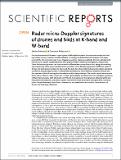Radar micro-Doppler signatures of drones and birds at K-band and W-band
Abstract
Due to the substantial increase in the number of affordable drones in the consumer market and their regrettable misuse, there is a need for efficient technology to detect drones in airspace. This paper presents the characteristic radar micro-Doppler properties of drones and birds. Drones and birds both induce micro-Doppler signatures due to their propeller blade rotation and wingbeats, respectively. These distinctive signatures can then be used to differentiate a drone from a bird, along with studying them separately. Here, experimental measurements of micro-Doppler signatures of different types of drones and birds are presented and discussed. The data have been collected using two radars operating at different frequencies; K-band (24 GHz) and W-band (94 GHz). Three different models of drones and four species of birds of varying sizes have been used for data collection. The results clearly demonstrate that a phase coherent radar system can retrieve highly reliable and distinctive micro-Doppler signatures of these flying targets, both at K-band and W-band. Comparison of the signatures obtained at the two frequencies indicates that the micro-Doppler return from the W-band radar has higher SNR. However, micro-Doppler features in the K-band radar returns also reveal the micro-motion characteristics of drones and birds very effectively.
Citation
Rahman , S & Robertson , D A 2018 , ' Radar micro-Doppler signatures of drones and birds at K-band and W-band ' , Scientific Reports , vol. 8 , 17396 . https://doi.org/10.1038/s41598-018-35880-9
Publication
Scientific Reports
Status
Peer reviewed
ISSN
2045-2322Type
Journal article
Description
The authors acknowledge the funding received from the Science and Technology Facilities Council which has supported this work under grant ST/N006569/1Collections
Items in the St Andrews Research Repository are protected by copyright, with all rights reserved, unless otherwise indicated.

